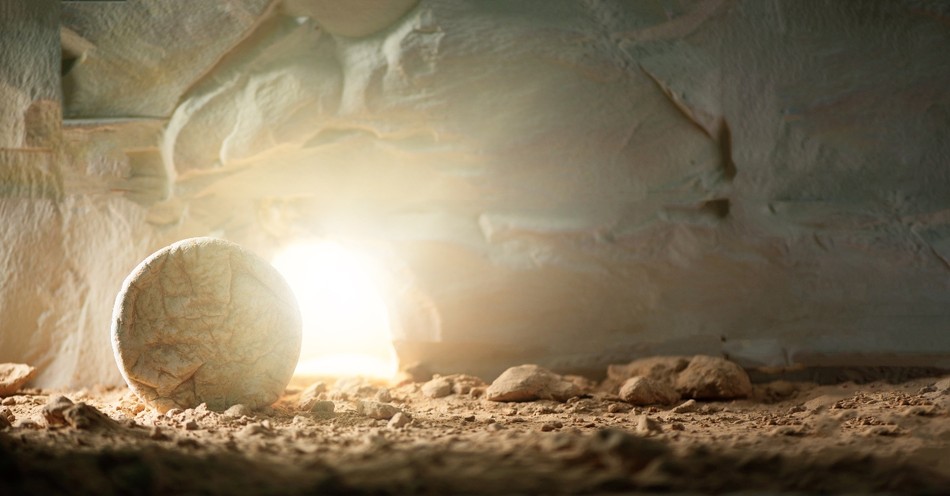Of all the teachings of Christianity, no doctrine is more central than the bodily resurrection of Jesus Christ from the dead. The truth of the resurrection has been attacked from every angle. New books and television media regularly appear questioning the resurrection, re-hashing old theories about what happened to Jesus’ body. Since the resurrection is crucial to Christianity, Christians ought to be able to give answers to these inevitable questions with proof and evidence.
The Gospel Accounts Showing the Resurrection of Jesus
The first step in defending the resurrection from its detractors is to establish the fact of the historical events that took place as conveyed in the Gospels. As philosopher William Lane Craig notes in his book Reasonable Faith, “The issue is whether the gospel narratives are historically credible accounts or unhistorical legends.”
Bible Verses about the Resurrection
1 Peter 1:3 - Blessed be the God and Father of our Lord Jesus Christ! According to his great mercy, he has caused us to be born again to a living hope through the resurrection of Jesus Christ from the dead,
1 Thessalonians 4:14 - For since we believe that Jesus died and rose again, even so, through Jesus, God will bring with him those who have fallen asleep.
Romans 8:11 - If the Spirit of him who raised Jesus from the dead dwells in you, he who raised Christ Jesus from the dead will also give life to your mortal bodies through his Spirit who dwells in you.
John 11:25-26 - Jesus said to her, “I am the resurrection and the life. Whoever believes in me, though he die, yet shall he live, and everyone who lives and believes in me shall never die. Do you believe this?”
The Resurrection's Key Proof: The Empty Tomb
One of the easiest parts of the resurrection data to establish is the fact that the tomb is empty. Because the location of Jesus’ burial was known to those living in Jerusalem, it is unlikely that they would have believed the apostles’ claims about the resurrection of Christ if there was not an empty tomb. Jesus’ burial is widely attested in early, independent testimonies, both biblical and extra-biblical.
The fact that women are primary witnesses of the empty tomb in the Gospel accounts is further evidence of their authenticity. This is because, as is often noted, women were not considered reliable witnesses in first-century Jewish culture, so it would have been foolish for the authors to fictionally construct an account involving women in order to gain credibility.
Matthew 28:11 speaks of a myth that was spread among the Jews concerning the body of Christ. Apparently, the Jews were saying the disciples stole the body of Christ. This is significant because the Jews did not deny the tomb was empty but instead sought an alternative explanation to the resurrection. The emptiness of the tomb is a widely attested historical fact.
However, just because the tomb of Jesus Christ was empty does not necessarily mean the resurrection happened. There are four alternative hypotheses to the resurrection that have been advanced over the years:
1. The Conspiracy Hypothesis
The conspiracy hypothesis says that the disciples stole the body of Jesus and continued to lie about his appearance to them. According to this account, the resurrection was a hoax.
This hypothesis is not commonly held in modern scholarship for several reasons:
- This hypothesis does not take into account that the disciples believed in the resurrection. It is highly unlikely that numerous disciples would have been willing to give up their lives defending a fabrication.
- It is unlikely that the idea of resurrection would have entered the minds of the disciples, as such an event was not connected to the Jewish idea of a Messiah. The scholar William Lane Craig writes, “If your favorite Messiah got himself crucified, then you either went home or else you got yourself a new Messiah. But the idea of stealing Jesus’ corpse and saying that God has raised him from the dead is hardly one that would have entered the minds of the disciples.”
- This hypothesis cannot account for the post-resurrection appearances of Christ.
2. The Apparent Death Hypothesis
The second hypothesis attempting to explain away the resurrection is the apparent death hypothesis. This view says Jesus was not completely dead when he was removed from the cross. Once in the tomb, Jesus was revived and escaped, thus convincing the disciples of his resurrection.
This view is difficult to hold for a few reasons:
- It is unlikely that a half-dead man would have been capable of even getting up to walk, much less moving the huge stone that sealed the tomb, over-powering Roman guards, and fleeing from sight.
- This theory cannot account for the disciples’ attribution of resurrection to Christ, for if they had seen him after he was revived, they would have merely thought he had never died.
- It is also foolish to think the Romans, who had perfected the art of executing people, would have let one slip by without ensuring he was dead.
- Finally, given the physical torture described in the Gospel accounts, it is highly unlikely that Jesus could have survived the crucifixion.
3. The Wrong Tomb Hypothesis
The wrong tomb hypothesis suggests that the women had gotten lost on their way to Jesus’ tomb and accidentally stumbled upon the caretaker of an empty tomb. When the caretaker said, “Jesus is not here,” the women were so disoriented they fled, their story later being developed into a resurrection myth.
Like the other theories, virtually no reputable scholars hold to this view. There are at least three reasons:
- First, this theory does not explain the post-resurrection appearances, and it is spurious to think that such a simple mistake would have led a first-century Jew to think a resurrection had happened.
- In light of the early evidence that is available concerning the location of Jesus’ tomb, it is almost impossible that the women would have confused its location.
- This hypothesis emphasizes that the caretaker of the tomb said that Christ was not there, but it passes over the next phrase: “He is risen!”
4. The Displaced Body Hypothesis
The displaced body hypothesis says Joseph of Arimathea placed Jesus’ body in his own tomb but later moved it to the criminal’s graveyard. The disciples were unaware that Jesus’ body had been moved and, therefore, wrongly inferred that he had risen from the dead.
Because of the spurious nature of this theory, virtually no modern scholars hold to it:
- This theory cannot account for the post-resurrection appearances of Christ or the origin of the Christian faith.
- It is unclear why Joseph would not have corrected the error of the disciples by simply showing them where he had moved the body of Jesus.
- The criminal graveyard, most likely, was quite close to the crucifixion site, so it would have made little sense why Joseph would not have simply buried Jesus there in the first place. In fact, it was against Jewish law to allow a body to be moved after it had already been buried.
Get your FREE 8-Day Prayer and Scripture Guide - Praying Through the Holy Week HERE. Print your own copy for a beautiful daily devotional leading up to Easter.
The Post-Resurrection Appearances of Jesus
In 1 Corinthians, an authentic letter composed by a man acquainted with the first disciples, the Apostle Paul claims that numerous people saw Jesus alive after his death (1 Corinthians 1:1).
It is fairly indisputable that Jesus actually appeared to the people that Paul mentions. Even the notorious New Testament critic Bart Ehrman admits, “we can say with some confidence that some of his disciples claimed to have seen Jesus alive.”
The gospels all speak of the post-resurrection appearances of Christ. It would be quite ridiculous to suggest that each of these events was a hallucination. Few scholars argue, therefore, that on different occasions, different groups of people had experiences of seeing Jesus. They, therefore, question whether the experiences were actual physical, bodily appearances of Christ. However, Paul leaves no room for a merely psychological experience. His theology of the resurrected body ensures that he meant that Christ actually appeared physically.
The resurrection is the most plausible explanation for the postmortem appearances of Christ. The alternative—the disciples were hallucinating—says nothing to explain the empty tomb. Nor does it explain the disciples’ belief in the resurrection. In typical psychological postmortem experiences, the person having the experience rarely would think that a dead person actually returned physically to life, as New Testament scholar N.T. Wright argues postmortem appearances in the ancient world would be more evidence that the person was dead than that he was alive.
The physical resurrection of Jesus proves to be the best explanation for the postmortem appearances described in 1 Corinthians 1:1.
The Existence of Christianity
The fact that Christianity started and grew is also evidence of the resurrection. For Jews, the Messiah was viewed as a figure that would be triumphant and rule on David’s throne, not a figure that would be crucified and die.
The resurrection of Jesus undid the catastrophe of the crucifixion. The Messiah, who had died, is risen! The resurrection validated and verified the claims Jesus had made about his own identity. The origin of Christianity rests solely on the fact that Jesus Christ rose from the dead.
It stands to reason that Jesus Christ did in fact rise from the dead victoriously on the third day after his death. No alternative hypothesis can adequately explain the empty tomb, the postmortem appearances of Jesus, and the origin of the Christian faith.
What 3 Facts Prove the Resurrection of Jesus?
Read a transcription of this video by Gary Habermas about the proof of Christ's resurrection:
Well, I'm the guy that goes through the key sources to see where scholars are today. If I'm going to tell you where scholars are across the board, I kind of have to have an idea where they're hanging out. And in the literature, this is hard to imagine. In the critical literature, I found over 20 reasons to believe in an empty tomb, over 20. You think really? I mean, where do you get that kind of thing. But critics are convinced, at least if you go by the times they mentioned it most, that the best reason to believe in the empty tomb is because the women are reported as witnesses. Now here's how it works.
If I'm faking a gospel or half faking, half telling the truth. And I don't mean that I'm a liar, that's way too simple. I'm telling a story about this great man, and I just kind of fill in the blanks with things that I've heard, you know, and I don't know what goes in there. And I'm writing this a few decades later. When I get to the important parts central part about empty tomb, where we're getting up to appearances, I don't pick women as my witnesses. Because it's not true that women couldn't testify in a court of law, they could. But there's an inverse relation between how important the subject matter was and whether you would use women witnesses. Maybe it's all you have. And in this case, at least the beginning till the disciples go there and who knows who else, that's all we have.
So why is it that four gospel writers, now they're not just down the block from each other, right? They're in different parts of the Roman empire. As they're telling the story, why do they all commit this sort of faux pas and say, "The women did it?" Why wouldn't you say, "Well, I'm pretty free to tell the story. I think I heard someone say Peter and John went there." Okay, well that's later in the accounts. But let's make them go there at the beginning. Are let's just say I misunderstood. I thought Peter and John were with the women and they went early in the morning. I mean, I'm looking to get the guys to that story. There's not a single man in the original trip to the tomb. How come it's told that way four times different parts of the empire? Because there wasn't a single guy in the group. That's just an oppressive reason. You don't put your worst foot forward unless you're trying to tell the truth.
Another key reason is the story's told in Jerusalem. Where does the preaching start? Jerusalem. Where's the empty tomb? Jerusalem. How was the tomb again? Empty. Well, a skeptic sometimes say, "Come on, your book Acts says that they don't start preaching for 50 days. You couldn't tell who the person was after 50 days." And I'd respond, "That's not the teaching. That's not the text. That's not what it says. You have to do justice to what the text says." And here's what the text says. It's empty. Not there's a body in the tomb, don't mind him. We don't know who he is, anyway. Nobody's in the tomb. If there's a body in the tomb, the preaching is false. The New Testament is an empty tomb, no tomb. I mean, nobody buried in the tomb. And so the fact that it was preached in Jerusalem where anybody could get there easily on an afternoon walk and prove it or disprove it, it only works if there's no body in the tomb, ie, empty.
A third good reason is again, critics look for different sources, different, you know, two heads are better than one. And they're not agreed. But of the five sources that I outlined for the gospels, they believe that we have three to four are independent, admitting the empty tomb. That's three out of four out of a five max. That's a pretty good indication. Those are three.
There's a number of other indications. I think they're the best ones. The women, the fact that it was preached geographically in the place that it could most readily be refuted, and the fact that we have several sources, independent sources for the empty tomb.
Further Reading
Why Is the Resurrection So Important?
The Resurrection of Christ - Easton's Bible Dictionary
6 Reasons We Can Believe in the Resurrection Of Jesus Christ
Learn more about the meaning and significance behind the Easter holiday and Holy Week celebrations:
What is Lent? and When Does Lent Start?
What is Ash Wednesday? and When is Ash Wednesday?
What is Palm Sunday?
What is Maundy Thursday?
What is Good Friday? and When is Good Friday?
What is Holy Saturday?
What is Easter? and When is Easter Sunday?
Easter Bible Verses
The Resurrection of Jesus
Easter Prayers



